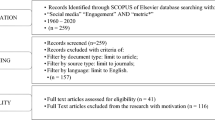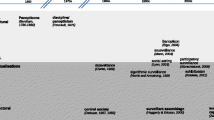Abstract
The paper presents the field of Visual Sociology as an approach that makes use of photographs, films, documentaries, videos, to capture and assess aspects of social life and social signals. It overviews some relevant works in the field, it deals with methodological and epistemological issues, by raising the question of the relation between the observer and the observed, and makes reference to some methods of analysis, such as those proposed by the Grounded Theory, and to some connected tools for automatic qualitative analysis, like NVivo. The relevance of visual sociology to the study of social signals lies in the fact that it can validly integrate the information, introducing a multi-modal approach in the analysis of social signals.
Similar content being viewed by others
References
Banks M (2008) Using visual data in qualitative research. Sage, London
Bateson G, Mead M (1942) Balinese character. A photographic analysis. New York Academy of Sciences, New York
Bauer MW, Gaskell G (eds) (2000) Qualitative researching with text, image and sound. Sage, London
Becker HS (1982) Art worlds. University of California Press, Berkeley
Becker H (1995) Backup of visual sociology, documentary photography, and photojournalism: it’s (almost) all a matter of context. Vis Sociol 10(1–2):5–14
Berger P (ed) (1977) Facing up to modernity. Basic Books, New York
Bogaart NCR, Katelaar HWER (eds) (1983) Methodology in anthropological filmmaking. Edition Herodot, Goettingen
Bourdieu P (sous la direction de) (1965) Un art moyen. Essai sur les usages sociaux de la photographie, Minuit, Paris; Photography. A Middle-b Row Art, Stanford University Press, Stanford, 1990
Canevacci M (2001) Antropologia della comunicazione visuale. Meltemi, Roma
Castells M (1996) The rise of the network society. Blackwell, Oxford
Chiozzi P (1993) Manuale di antropologia visiva. Unicopli, Milano
Deacy C, Arweck E (eds) (2009) Exploring religion and the sacred in a media age. Burlington (USA), Ashgate
De France C (1982) Cinéma et anthropologie. Éditions de la Maison des Sciences de l’Homme, Paris
Durkheim É (1895) Les règles de la méthode sociologique, Alcan, Paris; The elementary forms of the religious life. The totemic system in Australia, Free Press, New York, 1995
Ekman P, Rosenberg EL (2005) What the face reveals: basic and applied studies of spontaneous expression using the facial action coding system. Oxford University Press, Oxford
Faccioli F, Harper D (eds) (1999) Mondi da vedere. Verso una sociologia più visuale. Franco Angeli, Milano
Faccioli F, Losacco G (2003) Manuale di sociologia visuale. Franco Angeli, Milano
Faeta F (2003) Strategie dell’occhio. Saggi di etnografia visiva. Franco Angeli, Milano
Glaser B, Strauss A (1967) The discovery of grounded theory. Strategies for qualitative research. Aldine, New York
Grady J (2001) Becoming a visual sociologist. Sociol Imagin 38(1/2):83–119
Harper D (1998) An argument for visual sociology. In: Prosser J (ed) Image based research. A source book for qualitative researchers. Routledge, London, pp 24–41
Harper D (2010) Visual sociology. An introduction. Routledge, London
Heath C, Luff P, Hindmarsh J (2009) Audio visual methods in social research. Sage, London
Henny L (1980) Raising consciousness through film (II). The use of the audiovisual media in international development education. Sociological Institute, University of Utrecht, Utrecht
Henny L (1983) Video and the community. In Dowrick PW, Biggs SJ (eds) Using video. Psychological and social applications. Wiley, London, pp 167–177
Henny L (1986) Theory and practice of visual sociology. Curr Sociol 34(3):1–76
Hoover SM (2001) Visual religion in media culture. In: Morgan D, Promey S (eds) The visual culture of American religions. University of California Press, Berkeley, pp 146–159
Kissmann UT (ed) (2009) Video interaction analysis. Methods and methodology. Peter Lang, Frankfurt am Main
Knoblauch H, Schnettler B, Raab J, Soeffner H-G (eds) (2006) Video analysis: methodology and methods. qualitative audiovisual data analysis in sociology. Peter Lang, Frankfurt am Main
Kwan MP (2008) Methods in feminist geography. In: Nagy Hesse-Biber S, Leavy P (eds) Handbook of emergent methods. Guilford Press, New York
Lash S, Featherstone M (2001) Recognition and difference: politics, identity, multiculture. Theor Cult Soc 18(2–3):1–19
Losacco G (2003) Godstock. I papa boys al giubileo del 2000, Franco Angeli, Milano (with video-cassette)
Lyon D (2000) Jesus in Disneyland. Polity Press, Cambridge
Mattioli F (1991) Sociologia visuale. ERI, Torino
Mattioli F (2007) La sociologia visuale. Che cos’è e come si fa. Bonanno, Acireale-Roma
May C (2002) The information society. Polity Press, Cambridge
Mellor PA (2004) Religion, culture and society in the ‘information age’. Sociol Religion 65(4):357–371
Milic N (2008a) Balkanizing taxonomy. www.goldsmiths.ac.uk/balkanizing-taxonomy/exhibition.htm
Milic N (2008b) To memory and back. www.goldsmiths.ac.uk/balkanizing-taxonomy/essay.htm
Mitchell C (2009) Doing visual research. Sage, London
Morency L, de Kok I, Gratch J (2008) Context-based recognition during human interactions: automatic feature selection and encoding dictionary. In: Proceedings of the 10th international conference on multimodal interfaces, pp 181–188
Morgan M (2007) The Lure of images. A history of religion and visual media in America. Routledge, New York
Morgan D (2008) Key words in religion, media and culture. Routledge, New York
Pauwels L (2008) A private visual practice going public? Social functions and sociological research opportunities of web-based family photography. Vis Stud 23(1):34–49
Pink S (2005) The future of visual anthropology. Routledge, London
Pink S (2007) Doing visual ethnography: images, media and representation in research. Sage, London (1st ed. 2001)
Pink S (2009) Doing sensory ethnography. Sage, London
Rich M, Chalfen R (1999) Showing and telling asthma: children teaching physicians with visual narratives. Vis Sociol 14(1–2):51–71
Richardson L (2000) Writing: a method of inquiry. In: Denzin NK, Lincoln YS (eds) Handbook of qualitative research. Sage, London, pp 923–948
Rieger J (2003) A retrospective visual study of social change: the pulp-logging industry in an upper Peninsula Michigan country. Vis Stud 18(2):157–178
Rose G (2006) Visual methodologies. An introduction to the interpretation of visual methods. Sage, London
Ruby J (2000) Picturing culture. Explorations of film and anthropology. The University of Chicago Press, Chicago
Russell JA, Bachorowski J, Fernandez-Dols J (2003) Facial and vocal expressions of emotion. Annu Rev Psychol 54:329–349
Saukko P (2003) Doing research in cultural studies. Sage, London
Schnettler B, Raab J (2008) Interpretative visual analysis. Developments, state of art and the pending problems. Forum Qual Res 9(3):art. 31. http://nbn-resolving.de/urn:nbn:de:0114-fqs0803314
Secrist C, De Koeyer I, Bell H, Fogel A (2002) Combining video digital technology and narrative methods for understanding infant development. Forum Qual Res 3(2):24. http://nbn-resolving.de/urn:nbn:de:0114-fqs0202245
Sooryamoorthy R (2007) Behind the scenes. Making research films in sociology. Int Sociol 22(5):547–563
Stanczak G (ed) (2007) Visual research methods. Sage, London
Teddlie C, Tashakkori A (eds) (2003) Handbook of mixed methods in social and behavioral research. Sage, Thousand Oaks
Wright MJ (2007) Religion and film: an introduction. J. B. Taurus, London
Zeng Z, Pantic M, Roisman GI, Huang T (2009) A survey of affect recognition methods: audio, visual, and spontaneous expressions. IEEE Trans Pattern Anal Mach Intell 31(1):39–58
Zizek S (2002) Welcome to the desert of the real. Verso, London
Videos and films
De La Torre S, Funari V (2006) Maquilàpolis. Mexico/USA. www.maquilapolis.com
Peeva A (2003) Chia e tazi pesen? (Whose is this song). Adela Media Film and TV Production Company, Belgium/Bulgaria
Author information
Authors and Affiliations
Corresponding author
Additional information
This article is part of the Supplement Issue on “Social Signals. From Theory to Applications,” guest-edited by Isabella Poggi, Francesca D’Errico, and Alessandro Vinciarelli.
Rights and permissions
About this article
Cite this article
Cipriani, R., Del Re, E.C. Imagination and society: the role of visual sociology. Cogn Process 13 (Suppl 2), 455–463 (2012). https://doi.org/10.1007/s10339-012-0433-4
Received:
Accepted:
Published:
Issue Date:
DOI: https://doi.org/10.1007/s10339-012-0433-4




